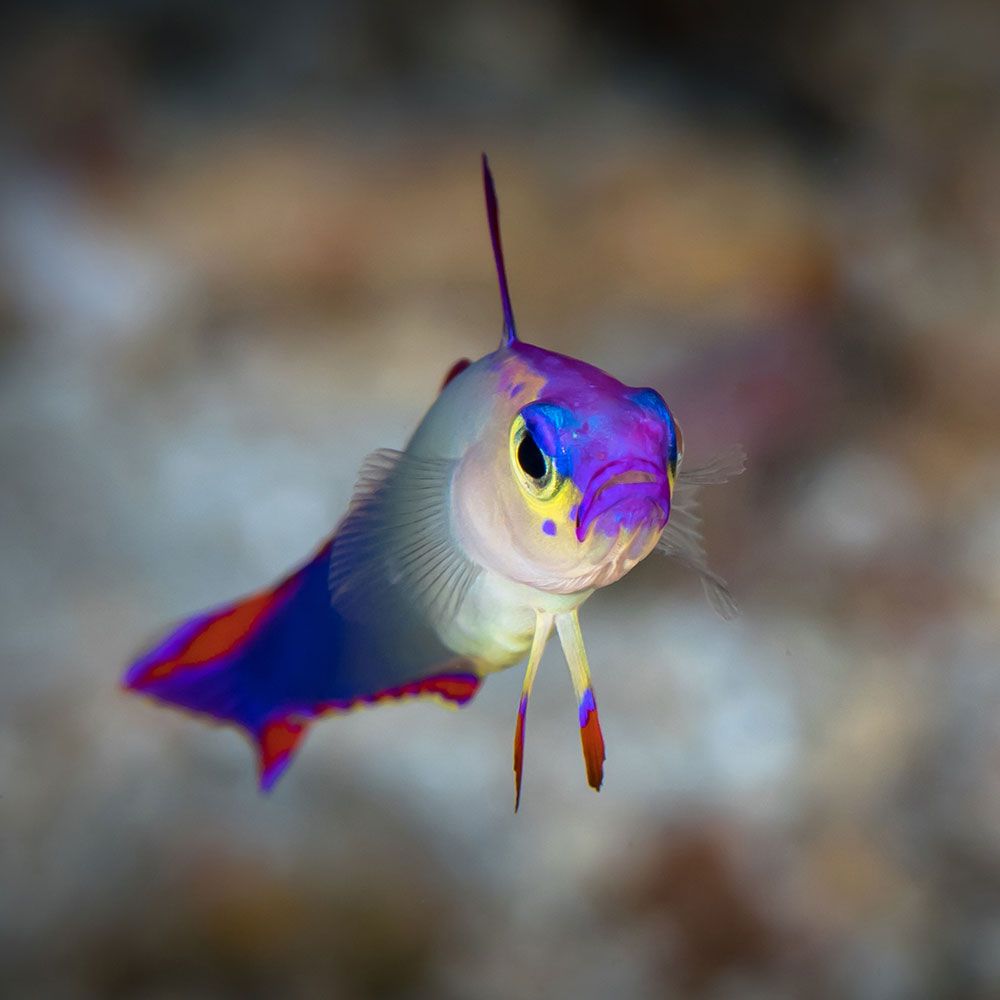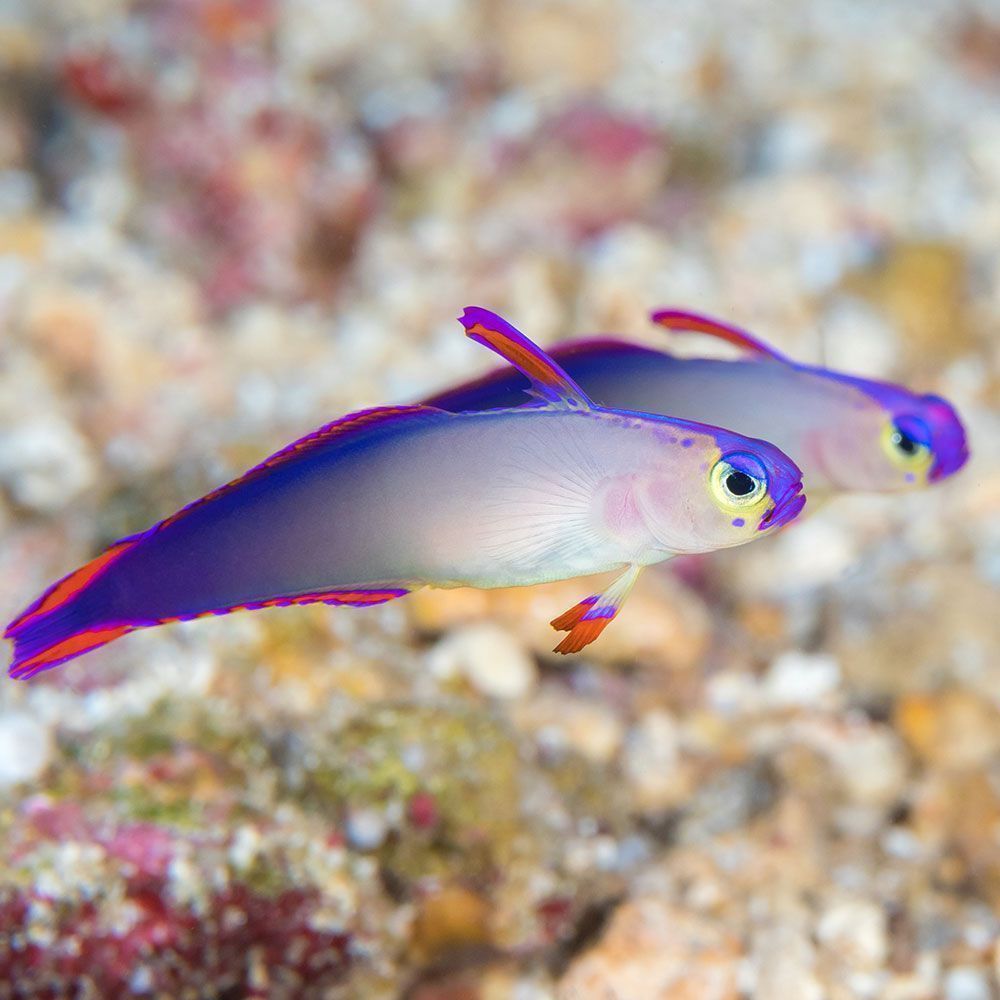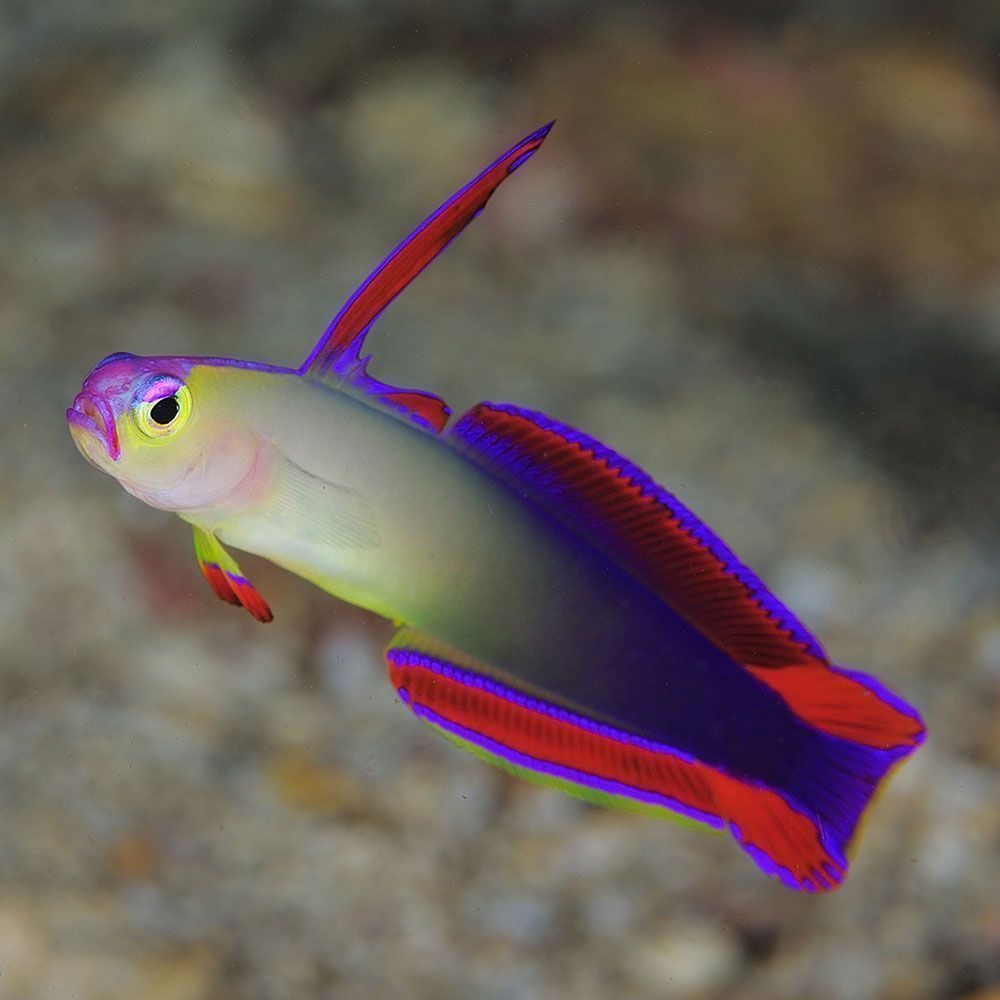The unique shading of this fish, along with reef-friendly behavior, makes it pretty desirable. It doesn’t try to uproot your corals.
So, if you want to add a colored pet to your reef aquarium, let’s head right in!
What is a Purple Firefish?
A purple firefish is one of the most popular saltwater aquarium fish among aquarists due to its unique appearance and friendly behavior.
| Origin | Indo-Pacific Ocean |
| Order | Gobiiformes |
| Family | Gobiidae |
| Scientific Name | Nemateleotris decora |
| Common Names | Purple firefish, elegant firefish, decorated firefish, purple firegoby, decorated dartfish, elegant dartfish, redbanner goby |
| IUCN Red List Status | Least Concern |
| Appearance | Slender body with purple head, silver/argent/yellowish body, and greyish-to-purple |
| Size | Up to 9.0 cm (3.54 in) |
| Lifespan | 3 years in captivity, while you can sustain it till 10 years in the best conditions |
| Temperament | Peaceful unless it is kept in confined tanks |
| Reef Safe | Yes |
| Tank Level | Mostly middle-dweller |
| Water Temperature | 73-80 °F (23-27 °C) |
| pH Level | 8.2-8.4 |
| Specific Gravity | 1.020-1.025 |
| Water Hardness | 8-12 dGH |
| Care Level | East to moderate |
| Minimum Tank Size | 30 gallons tank for a single fish. 55 gallons for two fish (a mated pair) |
| Tank Environment | Usually kept in nano reef aquariums with lots of hiding space and jumping space above the water surface |
| Diet | Omnivorous but more inclined to be carnivorous |
| Tank Mates | Small and calm fish |
Where is Purple Firefish Naturally Found?
This marine water fish is found in the Neritic Zone of Indo-Pacific oceans between Mauritius and Samoa, North of Ryukyu Islands, and South of New Caledonia.
The species mainly frequent between 25 to 70-meter depth underwater. It is often found at the reef base on hard and open bottoms. Or, it can even rest on the sand and rubble patches.
It is also found between the deep coast and outer reef drop-offs where the current is stronger.
In its natural habitat, the species mainly feed on zooplankton like copepods and crustacean larvae. It particularly faces the current to feast on these organisms.
The IUCN Red List of Threatened Species assessed purple firefish last in 2015 and listed it to be Least Concern.
Which is the family for Purple Firefish?
The fish belongs to the Gobiidae family and Gobiiformes order. Its scientific name is Nemateleotris decora.
Commonly, this species is known as purple firefish, elegant firefish, purple firegoby, decorated dartfish, decorated firefish, elegant dartfish, and redbanner goby.
This species is often confused with the fire dartfish.
Fun Fact: When the fish gets alarmed, it “darts” off to its hole in the substrate.
How does a Purple Firefish look?

The purple firefish is slender and colorful but now, it’s time to dive into the details.
What is the Size of Purple Firefish?
The total length of the male or unsexed fish is 9.0 cm in the wild. But its length varies between 7 to 9 cm in captivity. It reaches its complete size in 6 months to one year.
What is the Color of Purple Firefish?
The fish is bicolored with mostly argent (silver/white) and purple colors. Its head is purple while the body takes the argent shade with a hint of yellow. Lastly, the color darkens to deep grey and purple near the tail.
Its fins are strikingly colored with longitudinal bands. These bands are purple, black, red, and orange.
What are the Features of Purple Firefish?
The main features of the fish are as listed:
- Total dorsal spines: 7
- Total dorsal soft rays: 27-32
- Anal spines: 1
- Anal soft rays: 28-31
Are male and female Purple Firefish different from each other?
No, the sexual dimorphism is absent in this species.
How does Purple Firefish behave in the tank?
The fish is calm and peaceful with other calm species. However, it can often get into fights with its own species over territory.
It’s better to keep the fish as a pair of mates in each aquarium. The male and female pair don’t behave aggressively towards each other.
The fish is pretty active and is diurnal, i.e., stays awake during the daytime and rests at night.
What is the Lifespan of Purple Firefish?
The purple firefish lives for about 3 years in captivity. However, in the best situation, it can also live until 10 years.
Author’s Note: Though the fish is social, it can get aggressive with too many of its own species. But it can also get stressed from loneliness and expires earlier if kept alone.
How to take care of Purple Firefish?

This colorful species needs unique yet stable conditions to thrive. Here are all the details you may need.
What is the Tank Size of Purple Firefish?
For a single fish, a 30-gallon tank is sufficient. But for a pair of adult fish, go for a 55-gallon tank.
Make sure the aquarium hood is tightly secured as it is a prolific leaper. It might jump out of the tank and expire.
What is the Water Chemistry for Purple Firefish?
The fish is known to be particularly sensitive to chemicals. So, let’s know what water specifications are suitable to sustain it.
- pH Levels: 8.2-8.4
- Water Temperature: 73-80 °F (23-27 °C)
- Water Hardness: 8-12 dGH
- Ammonia: 0 ppm
- Nitrite: 0 ppm
- Nitrate: Below 25 ppm
- Synthetic Salt Level: 26-33 ppt
- Specific Gravity: 1.020-1.025
Did you know?
You can also create a seawater aquarium. For that, you need to take sea water, make sure it’s not polluted and follow these steps:
- Install living stone decoration
- Introduce invertebrates about one month later
- Introduce fish about 3 months after the last step or when microfauna appears
What is the Tank Environment for Purple Firefish?
In Summary, the tank environment must mimic the large and open sand area of the natural habitat of the fish. But let’s know a bit more in detail.
Which Substrate is used for Purple Firefish?
Add fine-grade sand substrate or plenty of loose coral rubble in the aquascape. Since the fish often digs burrows, this will protect it from fin disintegration.
You must also add a thick layer of substrate for the fish to dig burrows. This is a builder fish as it likes to modify the aquarium decor.
Which Lighting should be used for Purple Firefish?
The fish can thrive well under standard aquarium lights.
Which Décor should be used for Purple Firefish?
Add plenty of rockwork and caves in the aquarium for it to hide when alarmed. There must be a 15 cm gap between the water surface and the aquarium top to ensure the fish doesn’t hit the top when it jumps.
What Filtration system is needed for Purple Firefish?
Standard filtration is necessary like in any other aquarium. But you must install an oversized filtration system like a venturi system. One with 10-20 times your tank volume is perfect for strong oxygenation.
What is the Water Flow Rate for Purple Firefish?
It can stand a medium to strong water flow rate.
Fish Care Tip: Always approach your fish tank carefully. Otherwise, it’ll stress your fish out and shorten its lifespan. While handling the tank, be gentle as to not agitate it.
What does Purple Firefish eat?
The fish is omnivorous in nature but has a greater liking toward carnivorous feed.
So, it often thrives on a diet consisting of minutely chopped seafood, zooplankton, artemia, vitamin-enriched brine shrimp, mysis shrimp. and frozen meaty food.
The species also prefer high-grade flakes and pellets.
Dietary Tip: Feed it vitamin-enriched food to maintain its brilliant coloring. If the striking color fades away, you’ll know its health is declining.
What are the Tank Mates for Purple Firefish?
The best tankmates of the purple firefish are equally small or even smaller and calm fish.
For example, clownfish, butterflyfish, blue-green chromis, blennies, and pajama cardinalfish get along fine with the fish.
Which Tank Mates to Avoid for Purple Firefish?
It’s better to avoid any bigger, territorial, or aggressive fish.
What are the Common Diseases for Purple Firefish?
The purple firefish is mostly disease resistant, but you must still stay alert for these diseases.
| Disease Name | Causes | Symptoms | Treatment |
|---|---|---|---|
| Columnaris | Bacterial infection | Gray or white patched, fin fraying, lethargy. appetite loss | Better water quality, antibiotics, and stress reduction. |
| Ich | Parasitic infection | White spotting, flashing, lethargy, appetite loss | Temperature elevation in the tank (no more than 86 °F or 30 °C), aquarium salt addition, and ich medicines. |
| Fin Rot | Bacterial infection | Fin fraying or disintegration, appetite loss, lethargy | Water quality improvement, getting rid of all sources of physical injury, antibiotics. |
How to Breed Purple Firefish in an Aquarium?
This species is known to be monogamous and egg-layers. However, not much about its breeding is known under captivity.
However, the male and female fish pairs up and build nests in the wild. Each parent takes turns guarding the nest.
Breeding Tip: Avoid keeping multiple species of a common genus or multiple varieties under the same species. This will help you avoid hybridization.
A word from FishInAquarium
Though the purple firefish is social, you still can’t predict its nature towards other species. So, it’s better to put a pair together and expect them to be of opposite genders.
So, if this guide could answer all your questions and helped you prepare to get a new pet fish for yourself, share the link with fellow aquarists. And if you still have some queries, just drop us a mail and we will get back to you with the best possible information!


